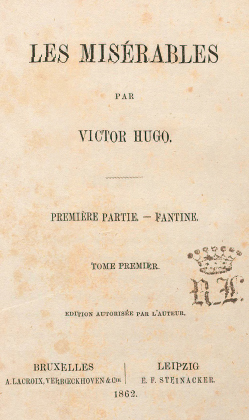
A romantic novel on an operatic scale. It’s no wonder that Victor Hugo’s tragic tale of compassion and redemption made such a successful adaptation to the musical stage. The book’s emotional scenes and detailed historical background are pure drama.
When Victor Hugo (1802–85) died, the crowd that attended his state funeral in Paris was larger than the entire population of the city. He was revered as a political philosopher as much as an author, having helped to shape France’s Third Republic. In France today, he is remembered for his poetry and plays as well as his novels; in the wider world his fame rests on The Hunchback of Notre-Dame and Les Misérables.
While The Hunchback of Notre-Dame evokes medieval Paris, Les Misérables is set in the France of Hugo’s childhood, its climax the failed Paris Uprising of 1832. Against this impoverished, violent background, Hugo tells the story of escaped petty thief Jean Valjean, constantly at risk of recapture and imprisonment by determined police inspector Javert.
Forgiven by a compassionate bishop for stealing silver candlesticks, Valjean is determined to turn over a new leaf. Under a false name he becomes a successful businessman. He takes pity on Fantine, a poor single mother fired from one of his factories, and when she dies he becomes a guardian to her daughter, Cosette.
Valjean and Javert cross paths repeatedly, and repeatedly find their moral beliefs at odds with either their self-interest or their sworn duty. Ultimately, each must be true to themselves, and on different occasions, each shows clemency to the other. For Javert the conflict is too great, and he kills himself. Valjean is driven to reveal his true identity as a former convict, which offends Cosette’s new husband, Marius. Marius severs all contact between his wife and Valjean, who has become a loving father figure to her. Valjean and the young couple are reunited only on Valjean’s deathbed.
Hidden identity is a recurring theme of Hugo’s book. Valjean and other characters frequently take on false names to conceal their pasts. Cosette’s former guardians, the Thénardiers, adopt a new surname when they start a new life in Paris, and Inspector Javert conceals his identity when he acts as a royalist spy behind the republican barricades. All such deceptions are doomed to failure in the novel.
Moral actions, however, are rewarded. When another man is falsely identified as Jean Valjean and arrested, the real Valjean reveals himself to prevent injustice. Valjean saves the unmasked spy Javert from a firing squad, an act which leads later to Javert not arresting Valjean when he could have. Les Misérables is a highly moral story in which compassion is the greatest virtue, leading always to redemption. It is a landmark of literary Romanticism.
Victor Hugo was already a celebrated author when Les Misérables was published in 1862. Critics objected to the politics, sentimentality, immorality and poverty illustrated by some of its characters, and the Catholic Church banned it outright. The reading public, however, loved it. The first English translation of it was published in New York only two months after the original French edition; the first British version appeared only four months after the American one. Both sold well. Anxious for news of its progress, Hugo telegraphed his London publisher with the briefest of messages: ‘?’ The publisher telegraphed back: ‘!’
